Corporate Governance and Ethics Report: [University Name]
VerifiedAdded on 2020/04/13
|14
|3077
|69
Report
AI Summary
This report provides a detailed analysis of corporate governance and ethics, beginning with an introduction to organizational culture and its impact on business environments. It explores the requirements for shaping and maintaining a mutual understanding of preferred cultures, along with strategies for monitoring and maintaining the prevalent organizational culture. The report then delves into Hofstede's cultural dimensions, including power distance, individualism, masculinity, uncertainty avoidance, long-term orientation, and indulgence, offering insights into how these dimensions influence organizational behavior across different cultures. Furthermore, the report examines the management approaches of millennials, discussing their advantages, challenges, and their significant role in shaping the future of business through their adaptability to new technologies and social media proficiency. The report concludes by highlighting the importance of understanding millennial perspectives and integrating them into modern organizational strategies for enhanced flexibility and purpose-driven work environments.
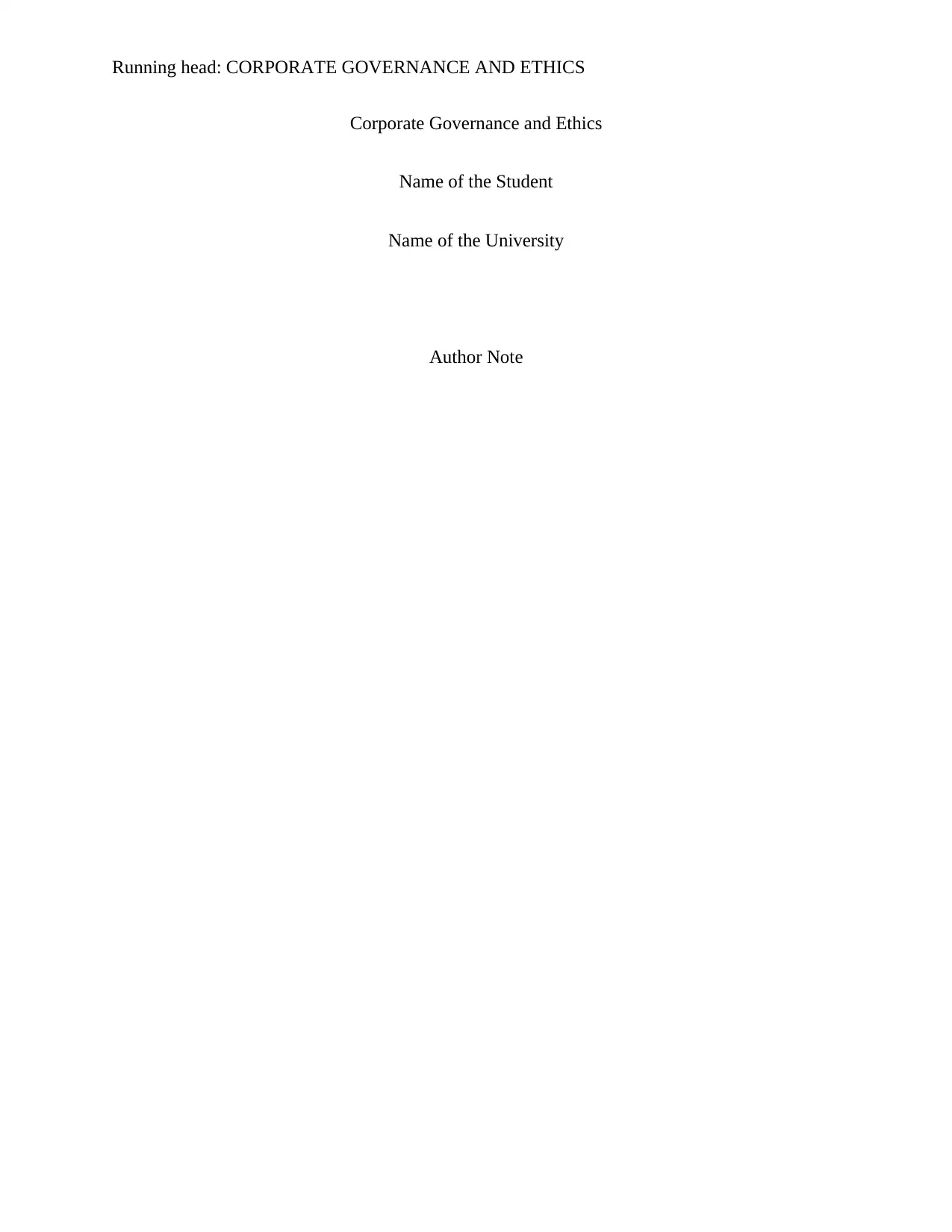
Running head: CORPORATE GOVERNANCE AND ETHICS
Corporate Governance and Ethics
Name of the Student
Name of the University
Author Note
Corporate Governance and Ethics
Name of the Student
Name of the University
Author Note
Paraphrase This Document
Need a fresh take? Get an instant paraphrase of this document with our AI Paraphraser
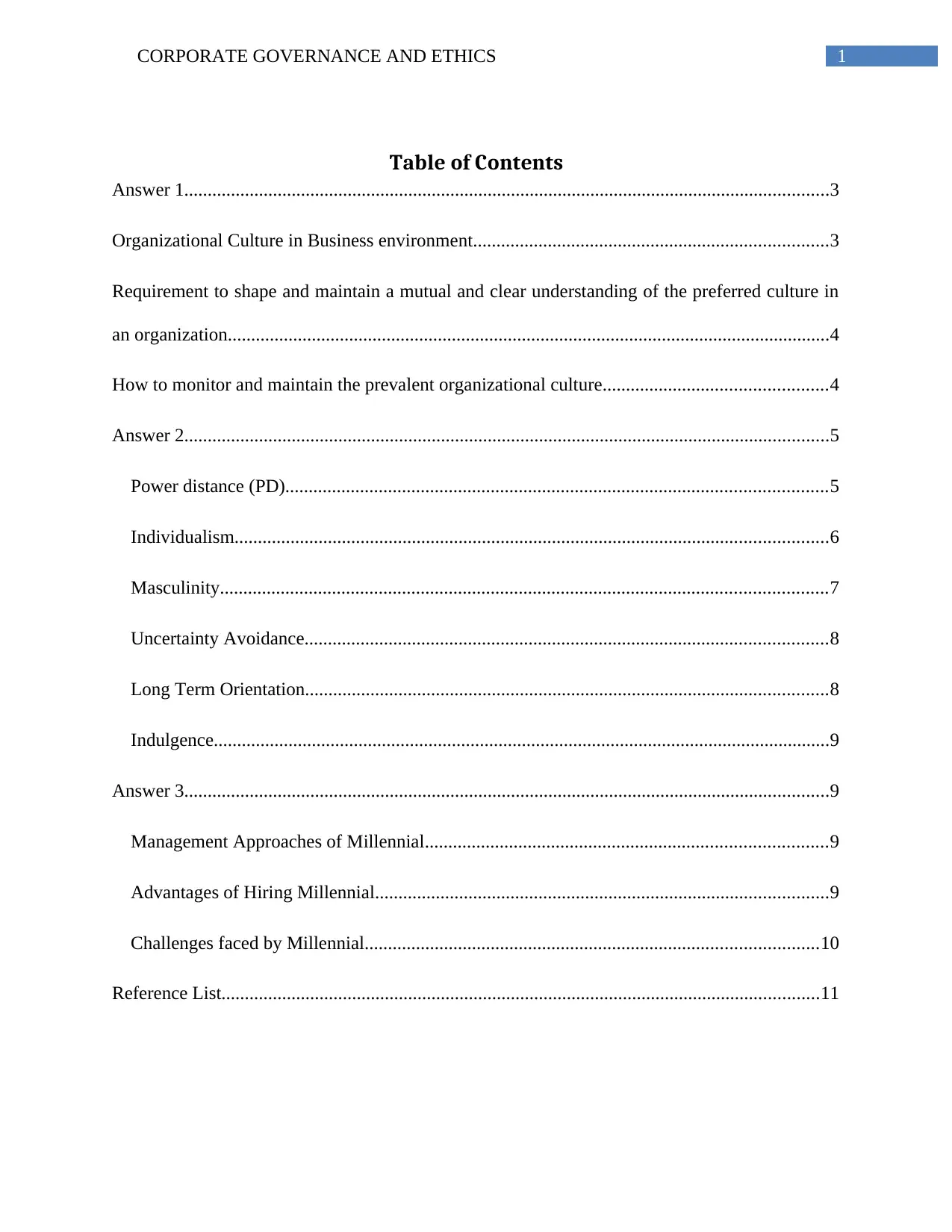
1CORPORATE GOVERNANCE AND ETHICS
Table of Contents
Answer 1..........................................................................................................................................3
Organizational Culture in Business environment............................................................................3
Requirement to shape and maintain a mutual and clear understanding of the preferred culture in
an organization.................................................................................................................................4
How to monitor and maintain the prevalent organizational culture................................................4
Answer 2..........................................................................................................................................5
Power distance (PD)....................................................................................................................5
Individualism...............................................................................................................................6
Masculinity..................................................................................................................................7
Uncertainty Avoidance................................................................................................................8
Long Term Orientation................................................................................................................8
Indulgence....................................................................................................................................9
Answer 3..........................................................................................................................................9
Management Approaches of Millennial......................................................................................9
Advantages of Hiring Millennial.................................................................................................9
Challenges faced by Millennial.................................................................................................10
Reference List................................................................................................................................11
Table of Contents
Answer 1..........................................................................................................................................3
Organizational Culture in Business environment............................................................................3
Requirement to shape and maintain a mutual and clear understanding of the preferred culture in
an organization.................................................................................................................................4
How to monitor and maintain the prevalent organizational culture................................................4
Answer 2..........................................................................................................................................5
Power distance (PD)....................................................................................................................5
Individualism...............................................................................................................................6
Masculinity..................................................................................................................................7
Uncertainty Avoidance................................................................................................................8
Long Term Orientation................................................................................................................8
Indulgence....................................................................................................................................9
Answer 3..........................................................................................................................................9
Management Approaches of Millennial......................................................................................9
Advantages of Hiring Millennial.................................................................................................9
Challenges faced by Millennial.................................................................................................10
Reference List................................................................................................................................11
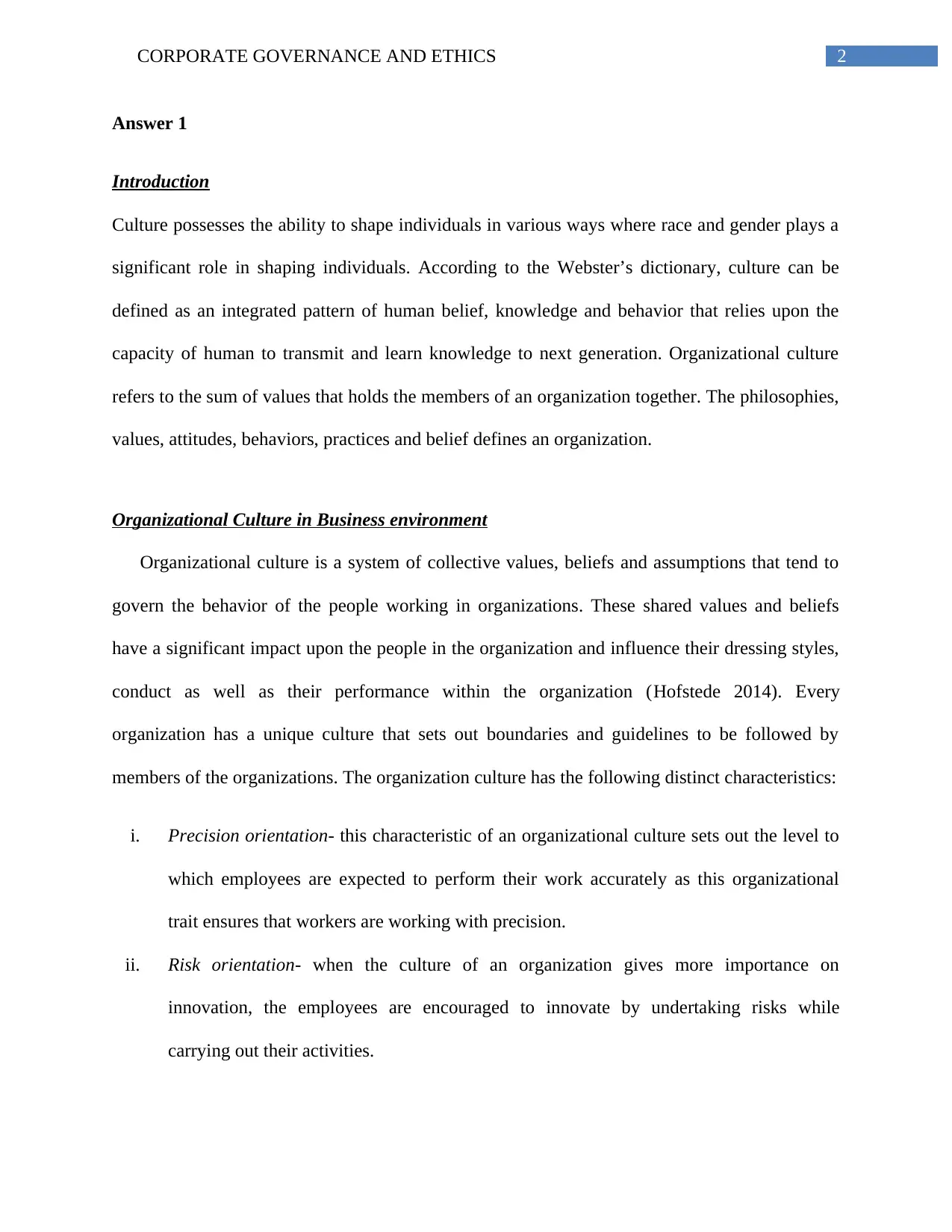
2CORPORATE GOVERNANCE AND ETHICS
Answer 1
Introduction
Culture possesses the ability to shape individuals in various ways where race and gender plays a
significant role in shaping individuals. According to the Webster’s dictionary, culture can be
defined as an integrated pattern of human belief, knowledge and behavior that relies upon the
capacity of human to transmit and learn knowledge to next generation. Organizational culture
refers to the sum of values that holds the members of an organization together. The philosophies,
values, attitudes, behaviors, practices and belief defines an organization.
Organizational Culture in Business environment
Organizational culture is a system of collective values, beliefs and assumptions that tend to
govern the behavior of the people working in organizations. These shared values and beliefs
have a significant impact upon the people in the organization and influence their dressing styles,
conduct as well as their performance within the organization (Hofstede 2014). Every
organization has a unique culture that sets out boundaries and guidelines to be followed by
members of the organizations. The organization culture has the following distinct characteristics:
i. Precision orientation- this characteristic of an organizational culture sets out the level to
which employees are expected to perform their work accurately as this organizational
trait ensures that workers are working with precision.
ii. Risk orientation- when the culture of an organization gives more importance on
innovation, the employees are encouraged to innovate by undertaking risks while
carrying out their activities.
Answer 1
Introduction
Culture possesses the ability to shape individuals in various ways where race and gender plays a
significant role in shaping individuals. According to the Webster’s dictionary, culture can be
defined as an integrated pattern of human belief, knowledge and behavior that relies upon the
capacity of human to transmit and learn knowledge to next generation. Organizational culture
refers to the sum of values that holds the members of an organization together. The philosophies,
values, attitudes, behaviors, practices and belief defines an organization.
Organizational Culture in Business environment
Organizational culture is a system of collective values, beliefs and assumptions that tend to
govern the behavior of the people working in organizations. These shared values and beliefs
have a significant impact upon the people in the organization and influence their dressing styles,
conduct as well as their performance within the organization (Hofstede 2014). Every
organization has a unique culture that sets out boundaries and guidelines to be followed by
members of the organizations. The organization culture has the following distinct characteristics:
i. Precision orientation- this characteristic of an organizational culture sets out the level to
which employees are expected to perform their work accurately as this organizational
trait ensures that workers are working with precision.
ii. Risk orientation- when the culture of an organization gives more importance on
innovation, the employees are encouraged to innovate by undertaking risks while
carrying out their activities.
⊘ This is a preview!⊘
Do you want full access?
Subscribe today to unlock all pages.

Trusted by 1+ million students worldwide
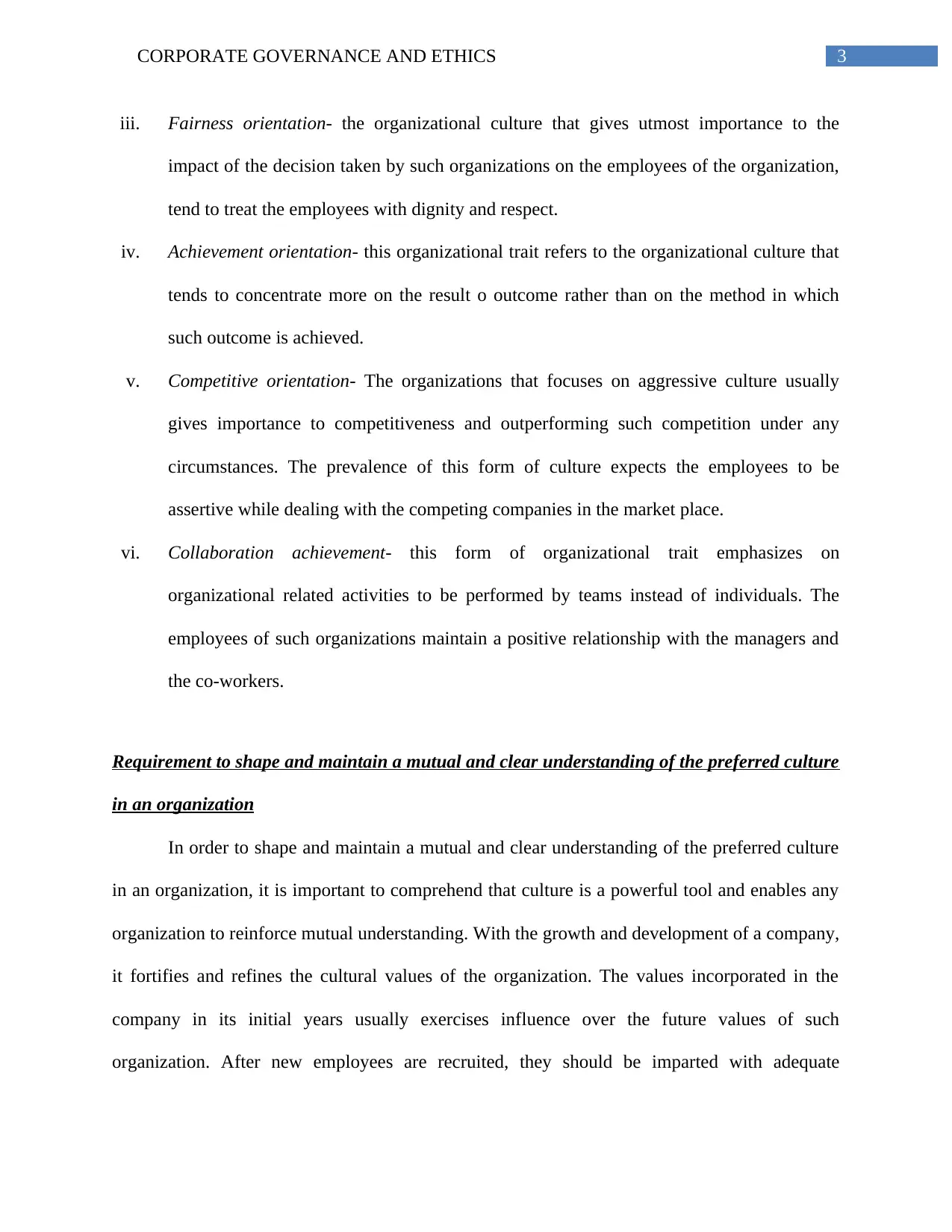
3CORPORATE GOVERNANCE AND ETHICS
iii. Fairness orientation- the organizational culture that gives utmost importance to the
impact of the decision taken by such organizations on the employees of the organization,
tend to treat the employees with dignity and respect.
iv. Achievement orientation- this organizational trait refers to the organizational culture that
tends to concentrate more on the result o outcome rather than on the method in which
such outcome is achieved.
v. Competitive orientation- The organizations that focuses on aggressive culture usually
gives importance to competitiveness and outperforming such competition under any
circumstances. The prevalence of this form of culture expects the employees to be
assertive while dealing with the competing companies in the market place.
vi. Collaboration achievement- this form of organizational trait emphasizes on
organizational related activities to be performed by teams instead of individuals. The
employees of such organizations maintain a positive relationship with the managers and
the co-workers.
Requirement to shape and maintain a mutual and clear understanding of the preferred culture
in an organization
In order to shape and maintain a mutual and clear understanding of the preferred culture
in an organization, it is important to comprehend that culture is a powerful tool and enables any
organization to reinforce mutual understanding. With the growth and development of a company,
it fortifies and refines the cultural values of the organization. The values incorporated in the
company in its initial years usually exercises influence over the future values of such
organization. After new employees are recruited, they should be imparted with adequate
iii. Fairness orientation- the organizational culture that gives utmost importance to the
impact of the decision taken by such organizations on the employees of the organization,
tend to treat the employees with dignity and respect.
iv. Achievement orientation- this organizational trait refers to the organizational culture that
tends to concentrate more on the result o outcome rather than on the method in which
such outcome is achieved.
v. Competitive orientation- The organizations that focuses on aggressive culture usually
gives importance to competitiveness and outperforming such competition under any
circumstances. The prevalence of this form of culture expects the employees to be
assertive while dealing with the competing companies in the market place.
vi. Collaboration achievement- this form of organizational trait emphasizes on
organizational related activities to be performed by teams instead of individuals. The
employees of such organizations maintain a positive relationship with the managers and
the co-workers.
Requirement to shape and maintain a mutual and clear understanding of the preferred culture
in an organization
In order to shape and maintain a mutual and clear understanding of the preferred culture
in an organization, it is important to comprehend that culture is a powerful tool and enables any
organization to reinforce mutual understanding. With the growth and development of a company,
it fortifies and refines the cultural values of the organization. The values incorporated in the
company in its initial years usually exercises influence over the future values of such
organization. After new employees are recruited, they should be imparted with adequate
Paraphrase This Document
Need a fresh take? Get an instant paraphrase of this document with our AI Paraphraser
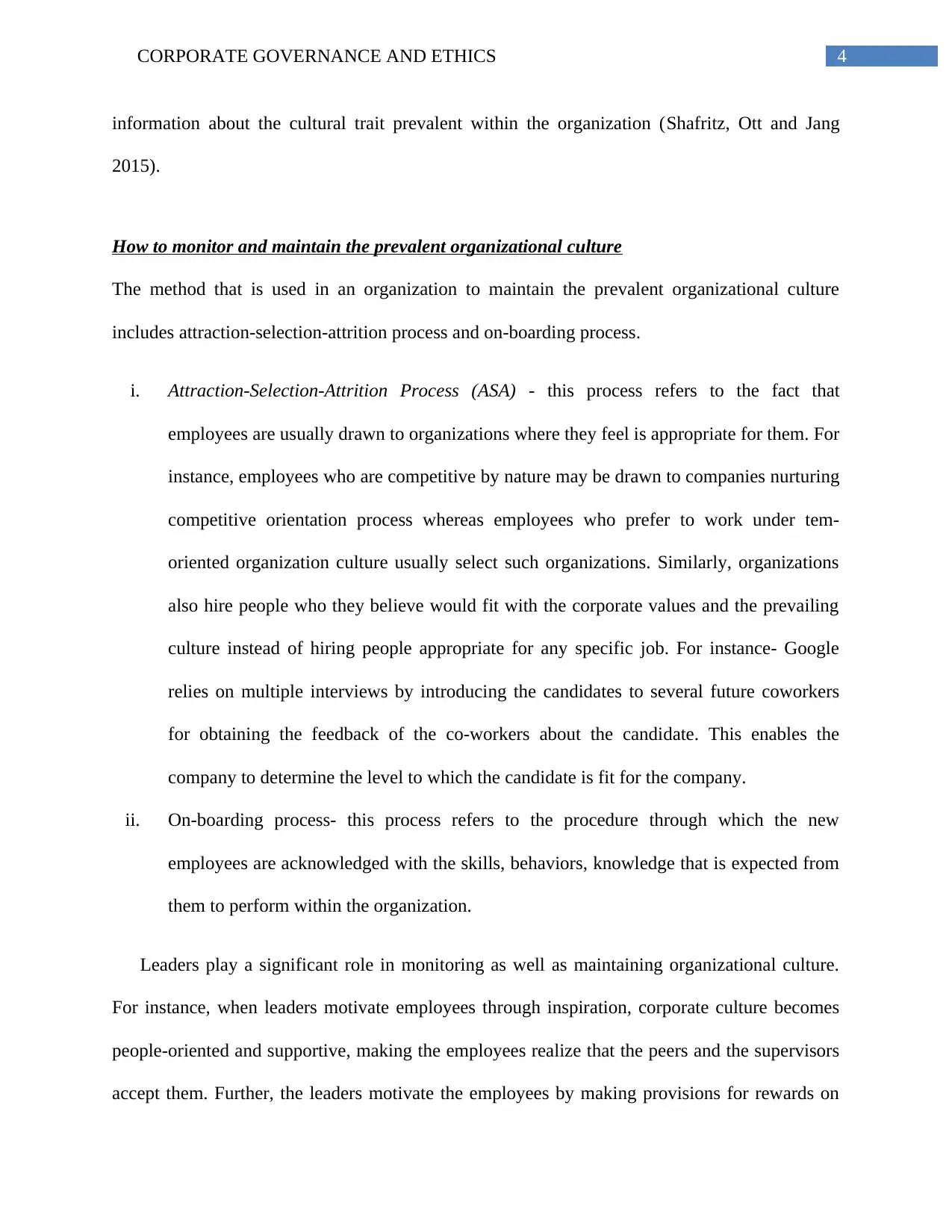
4CORPORATE GOVERNANCE AND ETHICS
information about the cultural trait prevalent within the organization (Shafritz, Ott and Jang
2015).
How to monitor and maintain the prevalent organizational culture
The method that is used in an organization to maintain the prevalent organizational culture
includes attraction-selection-attrition process and on-boarding process.
i. Attraction-Selection-Attrition Process (ASA) - this process refers to the fact that
employees are usually drawn to organizations where they feel is appropriate for them. For
instance, employees who are competitive by nature may be drawn to companies nurturing
competitive orientation process whereas employees who prefer to work under tem-
oriented organization culture usually select such organizations. Similarly, organizations
also hire people who they believe would fit with the corporate values and the prevailing
culture instead of hiring people appropriate for any specific job. For instance- Google
relies on multiple interviews by introducing the candidates to several future coworkers
for obtaining the feedback of the co-workers about the candidate. This enables the
company to determine the level to which the candidate is fit for the company.
ii. On-boarding process- this process refers to the procedure through which the new
employees are acknowledged with the skills, behaviors, knowledge that is expected from
them to perform within the organization.
Leaders play a significant role in monitoring as well as maintaining organizational culture.
For instance, when leaders motivate employees through inspiration, corporate culture becomes
people-oriented and supportive, making the employees realize that the peers and the supervisors
accept them. Further, the leaders motivate the employees by making provisions for rewards on
information about the cultural trait prevalent within the organization (Shafritz, Ott and Jang
2015).
How to monitor and maintain the prevalent organizational culture
The method that is used in an organization to maintain the prevalent organizational culture
includes attraction-selection-attrition process and on-boarding process.
i. Attraction-Selection-Attrition Process (ASA) - this process refers to the fact that
employees are usually drawn to organizations where they feel is appropriate for them. For
instance, employees who are competitive by nature may be drawn to companies nurturing
competitive orientation process whereas employees who prefer to work under tem-
oriented organization culture usually select such organizations. Similarly, organizations
also hire people who they believe would fit with the corporate values and the prevailing
culture instead of hiring people appropriate for any specific job. For instance- Google
relies on multiple interviews by introducing the candidates to several future coworkers
for obtaining the feedback of the co-workers about the candidate. This enables the
company to determine the level to which the candidate is fit for the company.
ii. On-boarding process- this process refers to the procedure through which the new
employees are acknowledged with the skills, behaviors, knowledge that is expected from
them to perform within the organization.
Leaders play a significant role in monitoring as well as maintaining organizational culture.
For instance, when leaders motivate employees through inspiration, corporate culture becomes
people-oriented and supportive, making the employees realize that the peers and the supervisors
accept them. Further, the leaders motivate the employees by making provisions for rewards on
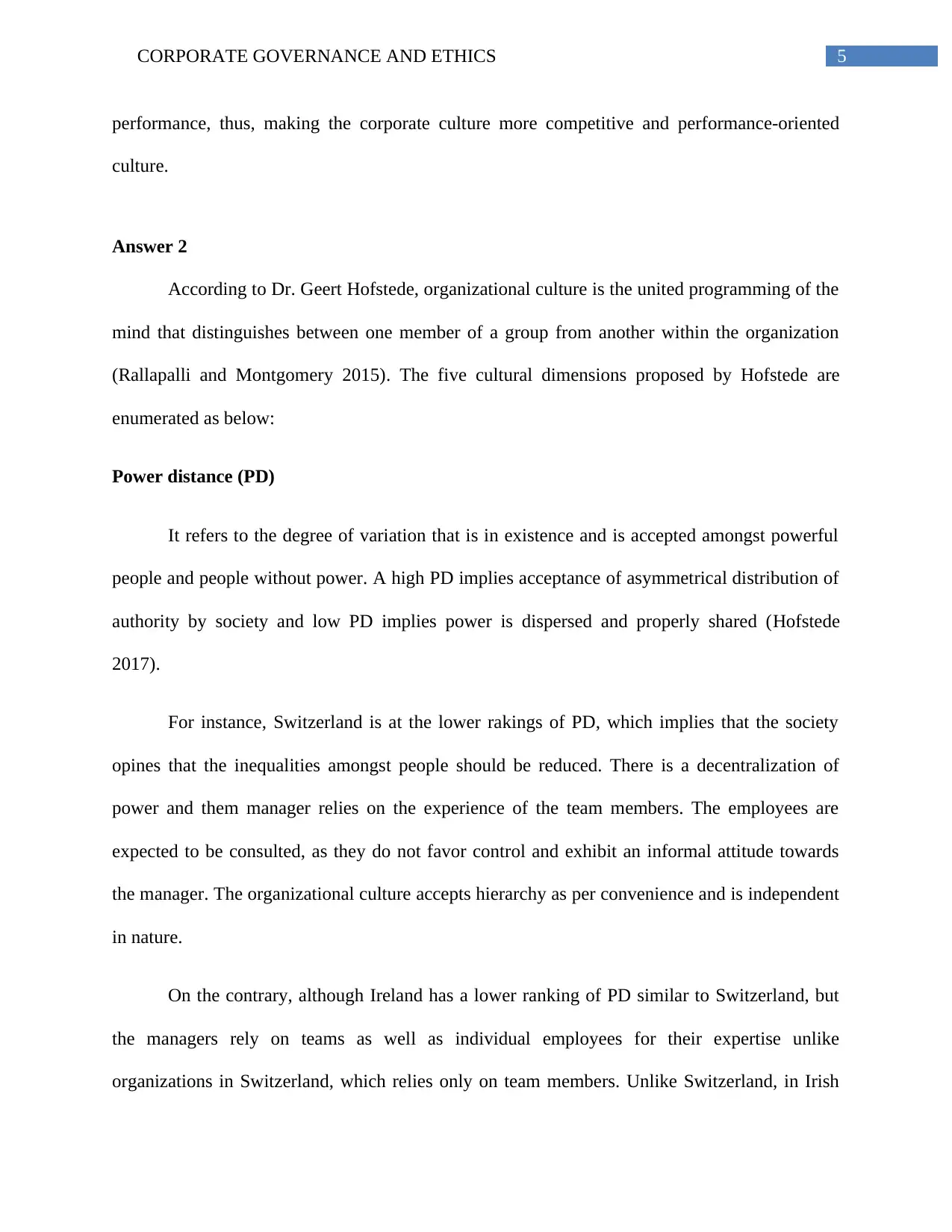
5CORPORATE GOVERNANCE AND ETHICS
performance, thus, making the corporate culture more competitive and performance-oriented
culture.
Answer 2
According to Dr. Geert Hofstede, organizational culture is the united programming of the
mind that distinguishes between one member of a group from another within the organization
(Rallapalli and Montgomery 2015). The five cultural dimensions proposed by Hofstede are
enumerated as below:
Power distance (PD)
It refers to the degree of variation that is in existence and is accepted amongst powerful
people and people without power. A high PD implies acceptance of asymmetrical distribution of
authority by society and low PD implies power is dispersed and properly shared (Hofstede
2017).
For instance, Switzerland is at the lower rakings of PD, which implies that the society
opines that the inequalities amongst people should be reduced. There is a decentralization of
power and them manager relies on the experience of the team members. The employees are
expected to be consulted, as they do not favor control and exhibit an informal attitude towards
the manager. The organizational culture accepts hierarchy as per convenience and is independent
in nature.
On the contrary, although Ireland has a lower ranking of PD similar to Switzerland, but
the managers rely on teams as well as individual employees for their expertise unlike
organizations in Switzerland, which relies only on team members. Unlike Switzerland, in Irish
performance, thus, making the corporate culture more competitive and performance-oriented
culture.
Answer 2
According to Dr. Geert Hofstede, organizational culture is the united programming of the
mind that distinguishes between one member of a group from another within the organization
(Rallapalli and Montgomery 2015). The five cultural dimensions proposed by Hofstede are
enumerated as below:
Power distance (PD)
It refers to the degree of variation that is in existence and is accepted amongst powerful
people and people without power. A high PD implies acceptance of asymmetrical distribution of
authority by society and low PD implies power is dispersed and properly shared (Hofstede
2017).
For instance, Switzerland is at the lower rakings of PD, which implies that the society
opines that the inequalities amongst people should be reduced. There is a decentralization of
power and them manager relies on the experience of the team members. The employees are
expected to be consulted, as they do not favor control and exhibit an informal attitude towards
the manager. The organizational culture accepts hierarchy as per convenience and is independent
in nature.
On the contrary, although Ireland has a lower ranking of PD similar to Switzerland, but
the managers rely on teams as well as individual employees for their expertise unlike
organizations in Switzerland, which relies only on team members. Unlike Switzerland, in Irish
⊘ This is a preview!⊘
Do you want full access?
Subscribe today to unlock all pages.

Trusted by 1+ million students worldwide
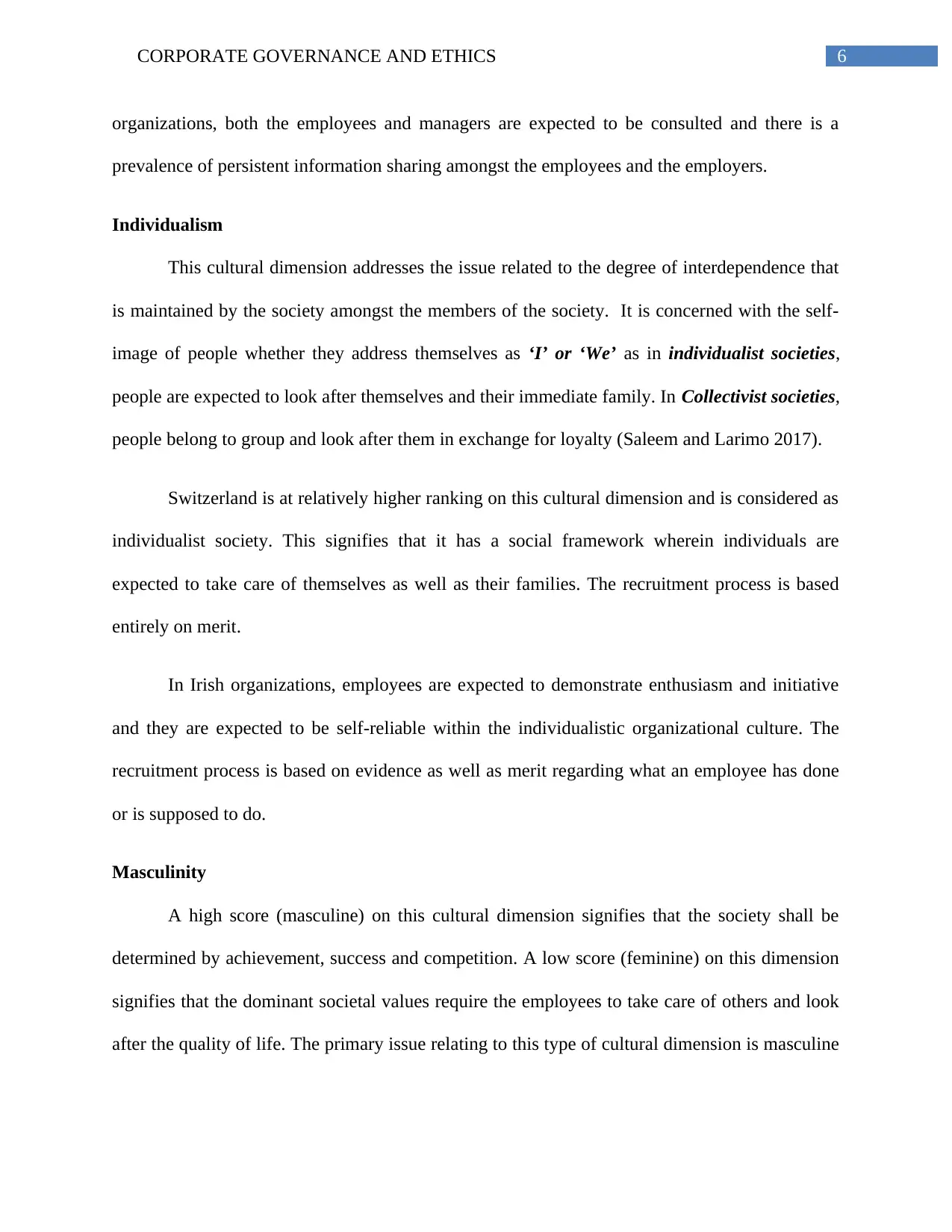
6CORPORATE GOVERNANCE AND ETHICS
organizations, both the employees and managers are expected to be consulted and there is a
prevalence of persistent information sharing amongst the employees and the employers.
Individualism
This cultural dimension addresses the issue related to the degree of interdependence that
is maintained by the society amongst the members of the society. It is concerned with the self-
image of people whether they address themselves as ‘I’ or ‘We’ as in individualist societies,
people are expected to look after themselves and their immediate family. In Collectivist societies,
people belong to group and look after them in exchange for loyalty (Saleem and Larimo 2017).
Switzerland is at relatively higher ranking on this cultural dimension and is considered as
individualist society. This signifies that it has a social framework wherein individuals are
expected to take care of themselves as well as their families. The recruitment process is based
entirely on merit.
In Irish organizations, employees are expected to demonstrate enthusiasm and initiative
and they are expected to be self-reliable within the individualistic organizational culture. The
recruitment process is based on evidence as well as merit regarding what an employee has done
or is supposed to do.
Masculinity
A high score (masculine) on this cultural dimension signifies that the society shall be
determined by achievement, success and competition. A low score (feminine) on this dimension
signifies that the dominant societal values require the employees to take care of others and look
after the quality of life. The primary issue relating to this type of cultural dimension is masculine
organizations, both the employees and managers are expected to be consulted and there is a
prevalence of persistent information sharing amongst the employees and the employers.
Individualism
This cultural dimension addresses the issue related to the degree of interdependence that
is maintained by the society amongst the members of the society. It is concerned with the self-
image of people whether they address themselves as ‘I’ or ‘We’ as in individualist societies,
people are expected to look after themselves and their immediate family. In Collectivist societies,
people belong to group and look after them in exchange for loyalty (Saleem and Larimo 2017).
Switzerland is at relatively higher ranking on this cultural dimension and is considered as
individualist society. This signifies that it has a social framework wherein individuals are
expected to take care of themselves as well as their families. The recruitment process is based
entirely on merit.
In Irish organizations, employees are expected to demonstrate enthusiasm and initiative
and they are expected to be self-reliable within the individualistic organizational culture. The
recruitment process is based on evidence as well as merit regarding what an employee has done
or is supposed to do.
Masculinity
A high score (masculine) on this cultural dimension signifies that the society shall be
determined by achievement, success and competition. A low score (feminine) on this dimension
signifies that the dominant societal values require the employees to take care of others and look
after the quality of life. The primary issue relating to this type of cultural dimension is masculine
Paraphrase This Document
Need a fresh take? Get an instant paraphrase of this document with our AI Paraphraser
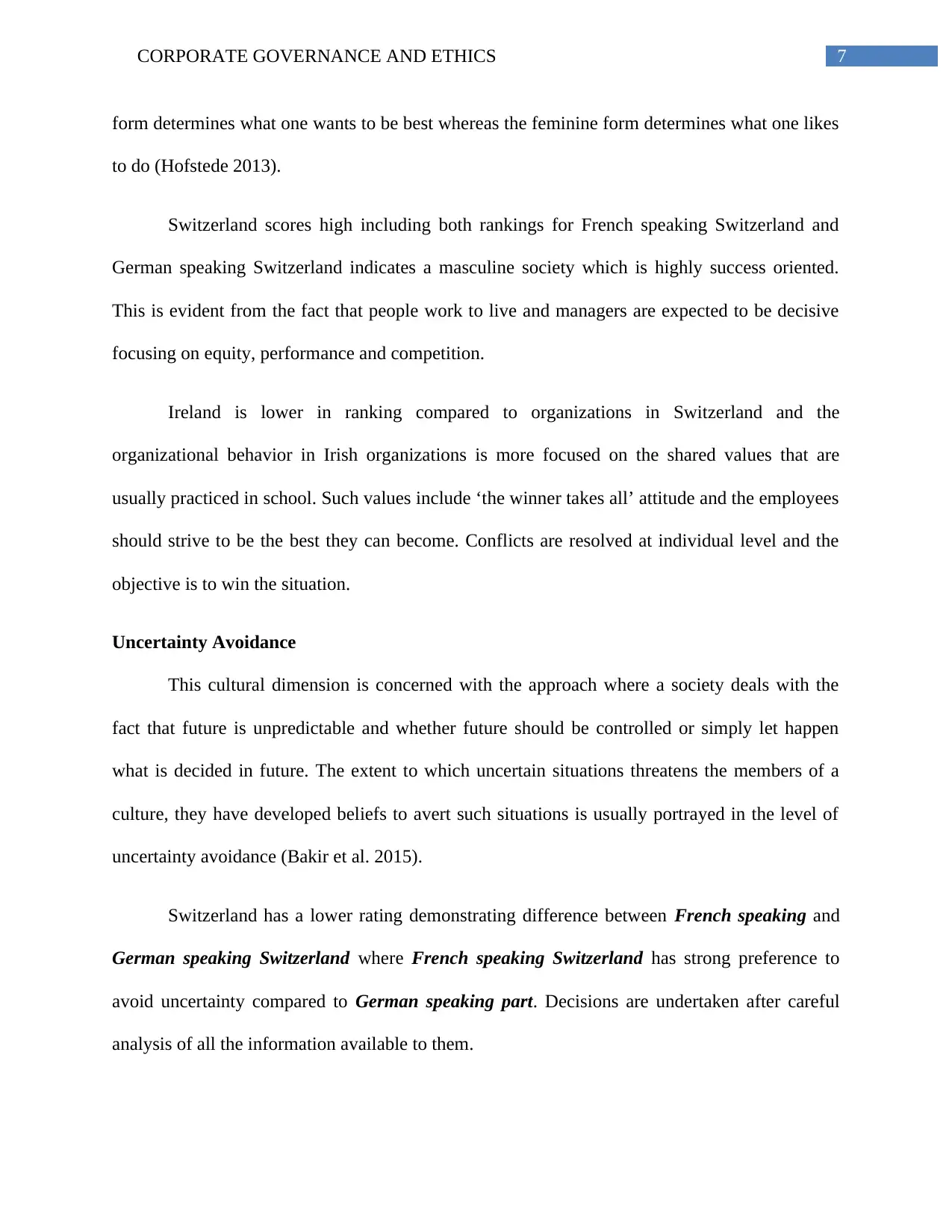
7CORPORATE GOVERNANCE AND ETHICS
form determines what one wants to be best whereas the feminine form determines what one likes
to do (Hofstede 2013).
Switzerland scores high including both rankings for French speaking Switzerland and
German speaking Switzerland indicates a masculine society which is highly success oriented.
This is evident from the fact that people work to live and managers are expected to be decisive
focusing on equity, performance and competition.
Ireland is lower in ranking compared to organizations in Switzerland and the
organizational behavior in Irish organizations is more focused on the shared values that are
usually practiced in school. Such values include ‘the winner takes all’ attitude and the employees
should strive to be the best they can become. Conflicts are resolved at individual level and the
objective is to win the situation.
Uncertainty Avoidance
This cultural dimension is concerned with the approach where a society deals with the
fact that future is unpredictable and whether future should be controlled or simply let happen
what is decided in future. The extent to which uncertain situations threatens the members of a
culture, they have developed beliefs to avert such situations is usually portrayed in the level of
uncertainty avoidance (Bakir et al. 2015).
Switzerland has a lower rating demonstrating difference between French speaking and
German speaking Switzerland where French speaking Switzerland has strong preference to
avoid uncertainty compared to German speaking part. Decisions are undertaken after careful
analysis of all the information available to them.
form determines what one wants to be best whereas the feminine form determines what one likes
to do (Hofstede 2013).
Switzerland scores high including both rankings for French speaking Switzerland and
German speaking Switzerland indicates a masculine society which is highly success oriented.
This is evident from the fact that people work to live and managers are expected to be decisive
focusing on equity, performance and competition.
Ireland is lower in ranking compared to organizations in Switzerland and the
organizational behavior in Irish organizations is more focused on the shared values that are
usually practiced in school. Such values include ‘the winner takes all’ attitude and the employees
should strive to be the best they can become. Conflicts are resolved at individual level and the
objective is to win the situation.
Uncertainty Avoidance
This cultural dimension is concerned with the approach where a society deals with the
fact that future is unpredictable and whether future should be controlled or simply let happen
what is decided in future. The extent to which uncertain situations threatens the members of a
culture, they have developed beliefs to avert such situations is usually portrayed in the level of
uncertainty avoidance (Bakir et al. 2015).
Switzerland has a lower rating demonstrating difference between French speaking and
German speaking Switzerland where French speaking Switzerland has strong preference to
avoid uncertainty compared to German speaking part. Decisions are undertaken after careful
analysis of all the information available to them.
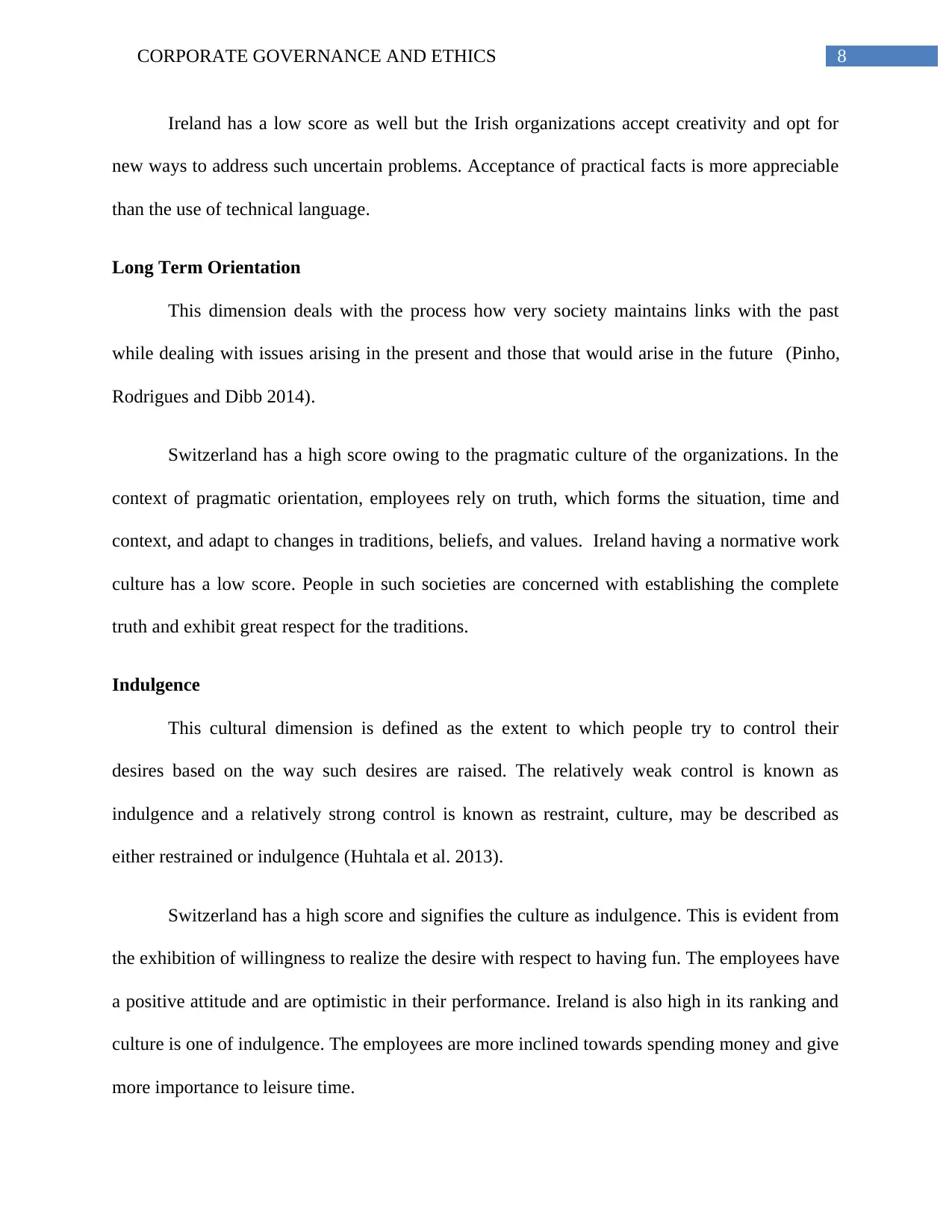
8CORPORATE GOVERNANCE AND ETHICS
Ireland has a low score as well but the Irish organizations accept creativity and opt for
new ways to address such uncertain problems. Acceptance of practical facts is more appreciable
than the use of technical language.
Long Term Orientation
This dimension deals with the process how very society maintains links with the past
while dealing with issues arising in the present and those that would arise in the future (Pinho,
Rodrigues and Dibb 2014).
Switzerland has a high score owing to the pragmatic culture of the organizations. In the
context of pragmatic orientation, employees rely on truth, which forms the situation, time and
context, and adapt to changes in traditions, beliefs, and values. Ireland having a normative work
culture has a low score. People in such societies are concerned with establishing the complete
truth and exhibit great respect for the traditions.
Indulgence
This cultural dimension is defined as the extent to which people try to control their
desires based on the way such desires are raised. The relatively weak control is known as
indulgence and a relatively strong control is known as restraint, culture, may be described as
either restrained or indulgence (Huhtala et al. 2013).
Switzerland has a high score and signifies the culture as indulgence. This is evident from
the exhibition of willingness to realize the desire with respect to having fun. The employees have
a positive attitude and are optimistic in their performance. Ireland is also high in its ranking and
culture is one of indulgence. The employees are more inclined towards spending money and give
more importance to leisure time.
Ireland has a low score as well but the Irish organizations accept creativity and opt for
new ways to address such uncertain problems. Acceptance of practical facts is more appreciable
than the use of technical language.
Long Term Orientation
This dimension deals with the process how very society maintains links with the past
while dealing with issues arising in the present and those that would arise in the future (Pinho,
Rodrigues and Dibb 2014).
Switzerland has a high score owing to the pragmatic culture of the organizations. In the
context of pragmatic orientation, employees rely on truth, which forms the situation, time and
context, and adapt to changes in traditions, beliefs, and values. Ireland having a normative work
culture has a low score. People in such societies are concerned with establishing the complete
truth and exhibit great respect for the traditions.
Indulgence
This cultural dimension is defined as the extent to which people try to control their
desires based on the way such desires are raised. The relatively weak control is known as
indulgence and a relatively strong control is known as restraint, culture, may be described as
either restrained or indulgence (Huhtala et al. 2013).
Switzerland has a high score and signifies the culture as indulgence. This is evident from
the exhibition of willingness to realize the desire with respect to having fun. The employees have
a positive attitude and are optimistic in their performance. Ireland is also high in its ranking and
culture is one of indulgence. The employees are more inclined towards spending money and give
more importance to leisure time.
⊘ This is a preview!⊘
Do you want full access?
Subscribe today to unlock all pages.

Trusted by 1+ million students worldwide
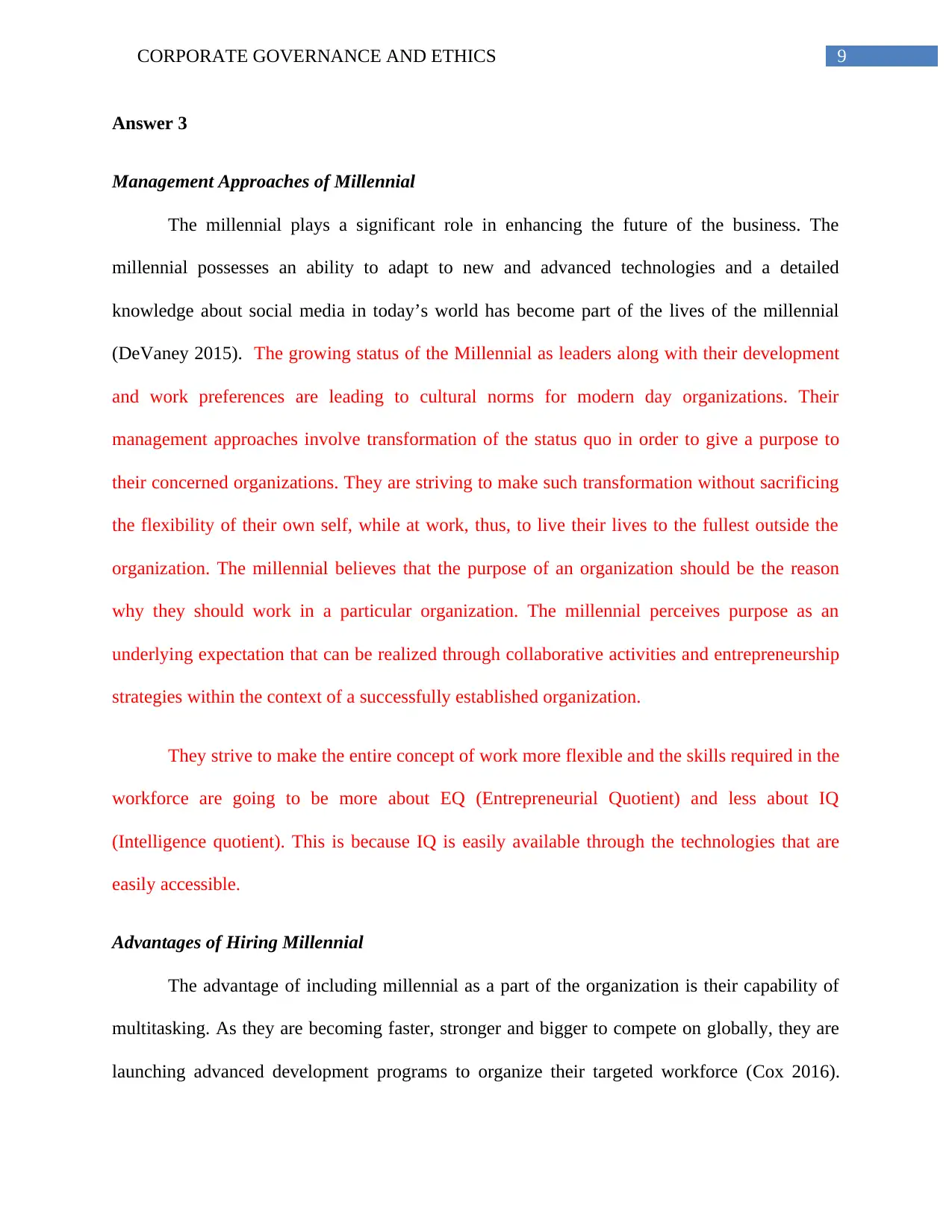
9CORPORATE GOVERNANCE AND ETHICS
Answer 3
Management Approaches of Millennial
The millennial plays a significant role in enhancing the future of the business. The
millennial possesses an ability to adapt to new and advanced technologies and a detailed
knowledge about social media in today’s world has become part of the lives of the millennial
(DeVaney 2015). The growing status of the Millennial as leaders along with their development
and work preferences are leading to cultural norms for modern day organizations. Their
management approaches involve transformation of the status quo in order to give a purpose to
their concerned organizations. They are striving to make such transformation without sacrificing
the flexibility of their own self, while at work, thus, to live their lives to the fullest outside the
organization. The millennial believes that the purpose of an organization should be the reason
why they should work in a particular organization. The millennial perceives purpose as an
underlying expectation that can be realized through collaborative activities and entrepreneurship
strategies within the context of a successfully established organization.
They strive to make the entire concept of work more flexible and the skills required in the
workforce are going to be more about EQ (Entrepreneurial Quotient) and less about IQ
(Intelligence quotient). This is because IQ is easily available through the technologies that are
easily accessible.
Advantages of Hiring Millennial
The advantage of including millennial as a part of the organization is their capability of
multitasking. As they are becoming faster, stronger and bigger to compete on globally, they are
launching advanced development programs to organize their targeted workforce (Cox 2016).
Answer 3
Management Approaches of Millennial
The millennial plays a significant role in enhancing the future of the business. The
millennial possesses an ability to adapt to new and advanced technologies and a detailed
knowledge about social media in today’s world has become part of the lives of the millennial
(DeVaney 2015). The growing status of the Millennial as leaders along with their development
and work preferences are leading to cultural norms for modern day organizations. Their
management approaches involve transformation of the status quo in order to give a purpose to
their concerned organizations. They are striving to make such transformation without sacrificing
the flexibility of their own self, while at work, thus, to live their lives to the fullest outside the
organization. The millennial believes that the purpose of an organization should be the reason
why they should work in a particular organization. The millennial perceives purpose as an
underlying expectation that can be realized through collaborative activities and entrepreneurship
strategies within the context of a successfully established organization.
They strive to make the entire concept of work more flexible and the skills required in the
workforce are going to be more about EQ (Entrepreneurial Quotient) and less about IQ
(Intelligence quotient). This is because IQ is easily available through the technologies that are
easily accessible.
Advantages of Hiring Millennial
The advantage of including millennial as a part of the organization is their capability of
multitasking. As they are becoming faster, stronger and bigger to compete on globally, they are
launching advanced development programs to organize their targeted workforce (Cox 2016).
Paraphrase This Document
Need a fresh take? Get an instant paraphrase of this document with our AI Paraphraser
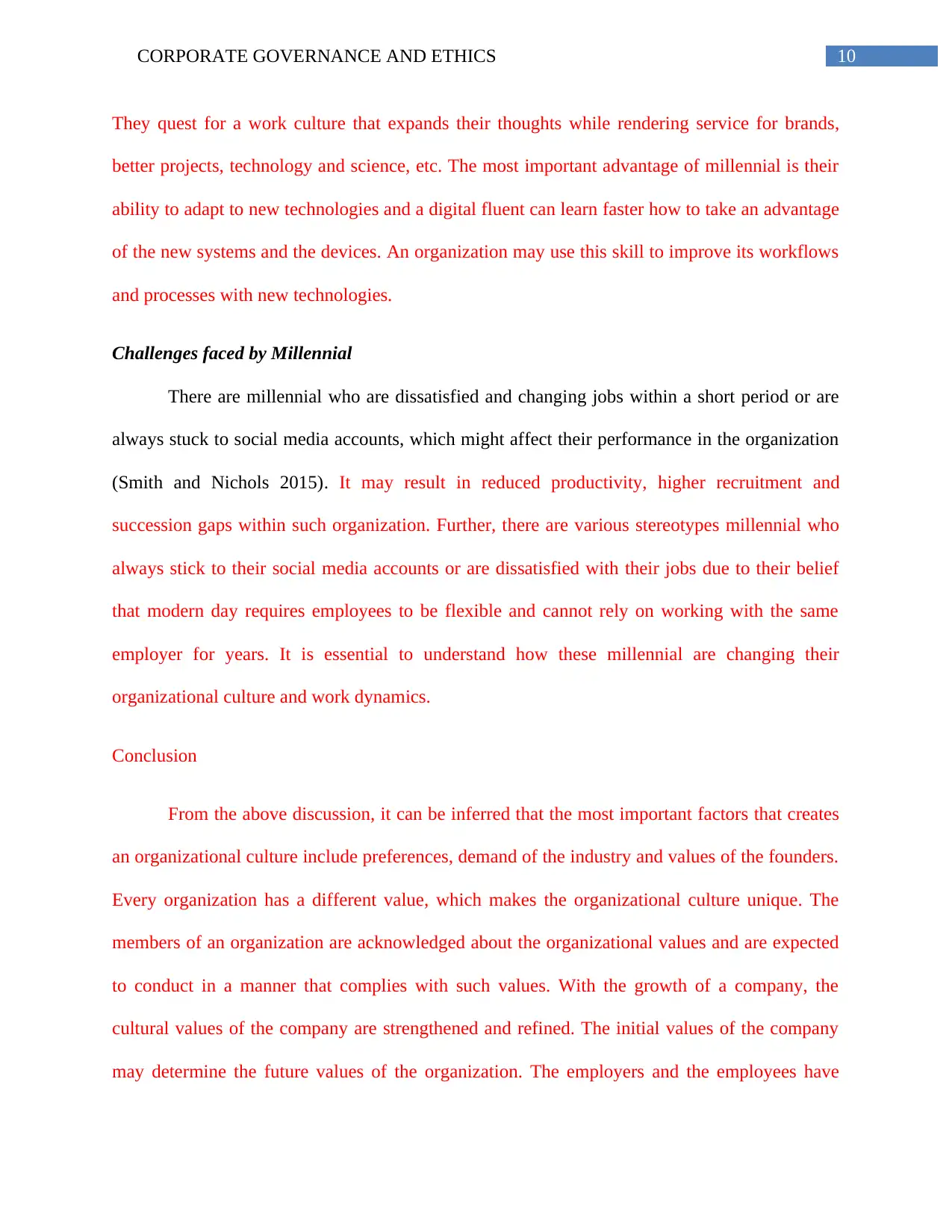
10CORPORATE GOVERNANCE AND ETHICS
They quest for a work culture that expands their thoughts while rendering service for brands,
better projects, technology and science, etc. The most important advantage of millennial is their
ability to adapt to new technologies and a digital fluent can learn faster how to take an advantage
of the new systems and the devices. An organization may use this skill to improve its workflows
and processes with new technologies.
Challenges faced by Millennial
There are millennial who are dissatisfied and changing jobs within a short period or are
always stuck to social media accounts, which might affect their performance in the organization
(Smith and Nichols 2015). It may result in reduced productivity, higher recruitment and
succession gaps within such organization. Further, there are various stereotypes millennial who
always stick to their social media accounts or are dissatisfied with their jobs due to their belief
that modern day requires employees to be flexible and cannot rely on working with the same
employer for years. It is essential to understand how these millennial are changing their
organizational culture and work dynamics.
Conclusion
From the above discussion, it can be inferred that the most important factors that creates
an organizational culture include preferences, demand of the industry and values of the founders.
Every organization has a different value, which makes the organizational culture unique. The
members of an organization are acknowledged about the organizational values and are expected
to conduct in a manner that complies with such values. With the growth of a company, the
cultural values of the company are strengthened and refined. The initial values of the company
may determine the future values of the organization. The employers and the employees have
They quest for a work culture that expands their thoughts while rendering service for brands,
better projects, technology and science, etc. The most important advantage of millennial is their
ability to adapt to new technologies and a digital fluent can learn faster how to take an advantage
of the new systems and the devices. An organization may use this skill to improve its workflows
and processes with new technologies.
Challenges faced by Millennial
There are millennial who are dissatisfied and changing jobs within a short period or are
always stuck to social media accounts, which might affect their performance in the organization
(Smith and Nichols 2015). It may result in reduced productivity, higher recruitment and
succession gaps within such organization. Further, there are various stereotypes millennial who
always stick to their social media accounts or are dissatisfied with their jobs due to their belief
that modern day requires employees to be flexible and cannot rely on working with the same
employer for years. It is essential to understand how these millennial are changing their
organizational culture and work dynamics.
Conclusion
From the above discussion, it can be inferred that the most important factors that creates
an organizational culture include preferences, demand of the industry and values of the founders.
Every organization has a different value, which makes the organizational culture unique. The
members of an organization are acknowledged about the organizational values and are expected
to conduct in a manner that complies with such values. With the growth of a company, the
cultural values of the company are strengthened and refined. The initial values of the company
may determine the future values of the organization. The employers and the employees have
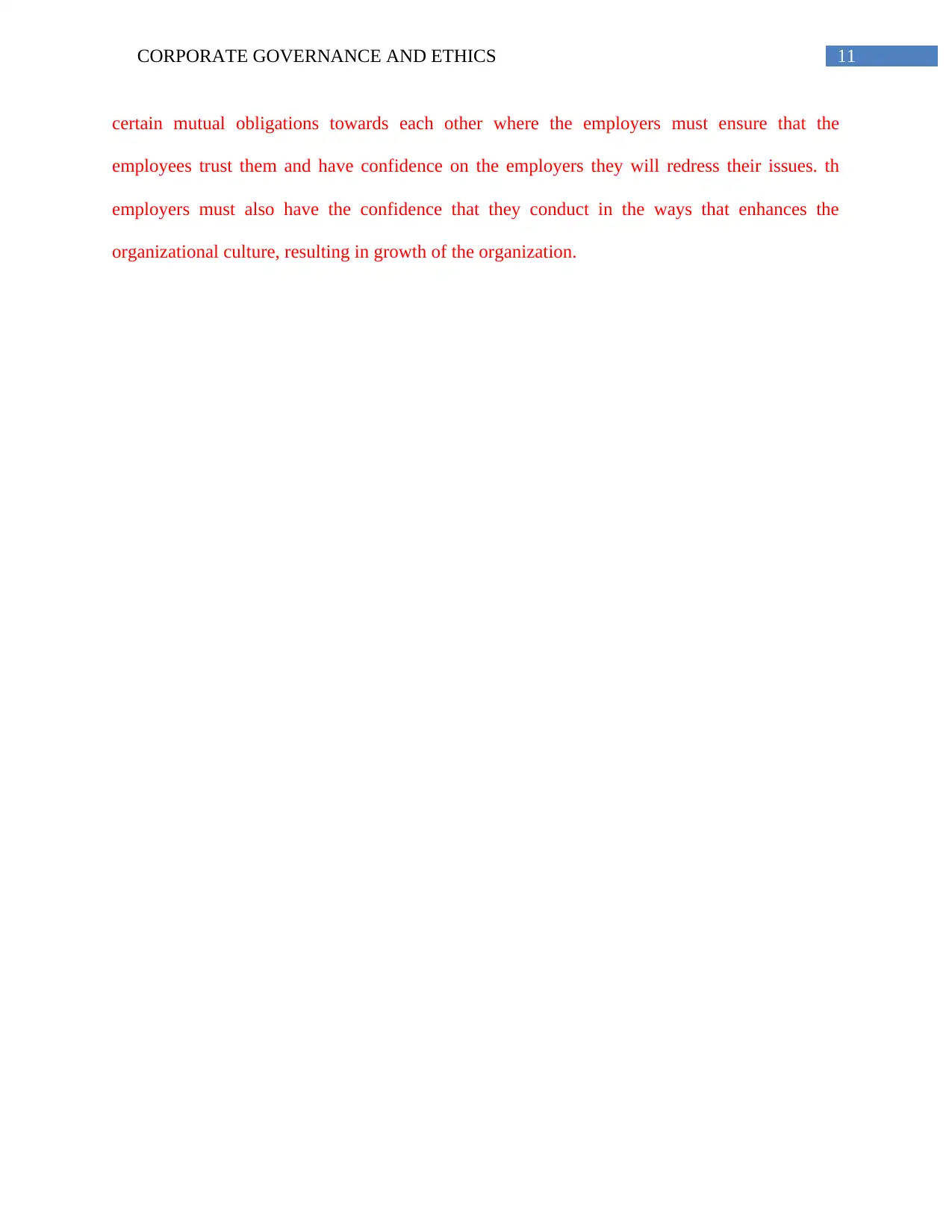
11CORPORATE GOVERNANCE AND ETHICS
certain mutual obligations towards each other where the employers must ensure that the
employees trust them and have confidence on the employers they will redress their issues. th
employers must also have the confidence that they conduct in the ways that enhances the
organizational culture, resulting in growth of the organization.
certain mutual obligations towards each other where the employers must ensure that the
employees trust them and have confidence on the employers they will redress their issues. th
employers must also have the confidence that they conduct in the ways that enhances the
organizational culture, resulting in growth of the organization.
⊘ This is a preview!⊘
Do you want full access?
Subscribe today to unlock all pages.

Trusted by 1+ million students worldwide
1 out of 14
Related Documents
Your All-in-One AI-Powered Toolkit for Academic Success.
+13062052269
info@desklib.com
Available 24*7 on WhatsApp / Email
![[object Object]](/_next/static/media/star-bottom.7253800d.svg)
Unlock your academic potential
Copyright © 2020–2025 A2Z Services. All Rights Reserved. Developed and managed by ZUCOL.



![Argumentative Essay on Organizational Behaviour - [University Name]](/_next/image/?url=https%3A%2F%2Fdesklib.com%2Fmedia%2Fimages%2Fhj%2Fb90705dcd0914a5ca9afd01837d6f50c.jpg&w=256&q=75)

